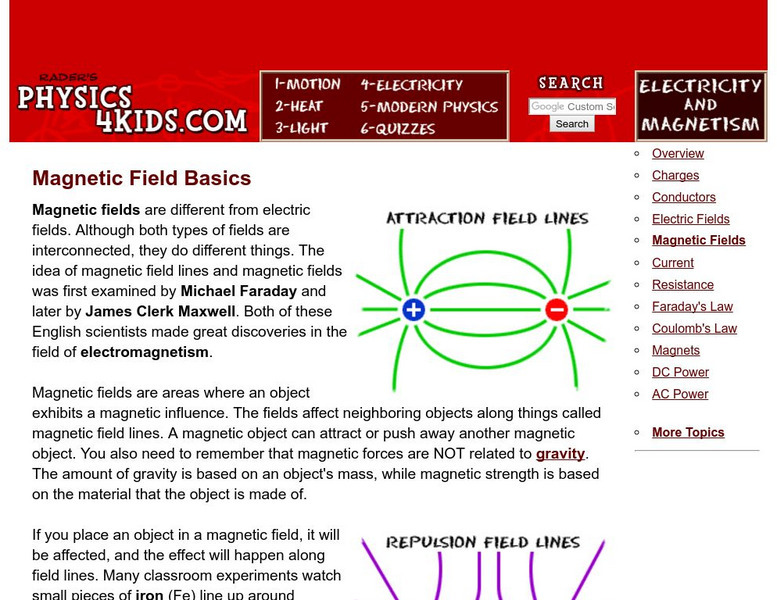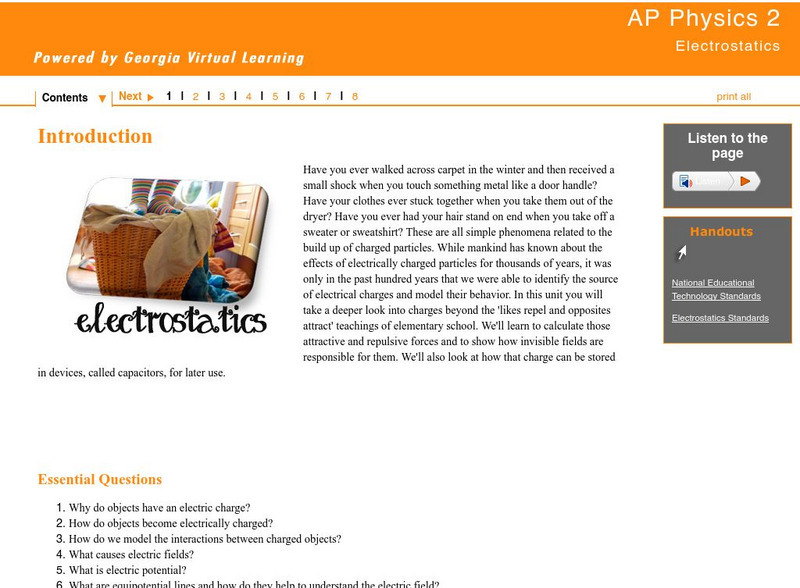TeachEngineering
Teach Engineering: The Electric and Magnetic Personalities of Mr. Maxwell
Learners are briefly introduced to Maxwell's equations and their significance to phenomena associated with electricity and magnetism. Basic concepts such as current, electricity and field lines are covered and reinforced. Through...
TeachEngineering
Teach Engineering: Circuits and Magnetic Fields
In this activity, students use the same method as in the activity from lesson 2 to explore the magnetism due to electric current instead of a permanent magnet. Students use a compass and circuit to trace the magnetic field lines induced...
TeachEngineering
Teach Engineering: Drawing Magnetic Fields
Students use a compass and a permanent magnet to trace the magnetic field lines produced by the magnet. By positioning the compass in enough spots around the magnet, the overall magnet field will be evident from the collection of arrows...
Khan Academy
Khan Academy: Electrical Engineering: Electrostatics
Electrostatics is the study of forces between charges, as described by Coulomb's Law. We develop the concept of an electric field surrounding charges. We work through examples of the electric field near a line, and near a plane, and...
Florida State University
Florida State University: Inductance
This article surveys inductance and its different forms. It discusses numerous topics associated with inductance such as Faraday's Law, self and mutual inductance, inductors, and magnetic field lines.
Physics Aviary
Physics Aviary: Practice Problems: Force Electric in a Line
Students must find the net force on one of the charges in a line of charges.
Physics4kids
Physics4 Kids: Electricity and Magnetism: Magnetic Fields
Explains magnetic fields, how they differ from electric fields, and attraction and repulsion.
University of Colorado
University of Colorado: Physics 2000: More About Visualizing Electromagnetic Waves
Discusses the nature of an electromagnetic wave. Explains the oscillating electric field and represents it through clever graphics and animations.
Other
Quackwatch: Power Lines and Cancer Nothing to Fear
This site explores the history of power lines and cancer associations, as well as dispelling the myth. The science is explored by citing known facts, studies and experts in the field.
Georgia Department of Education
Ga Virtual Learning: Ap Physics 2: Electrostatics
In this unit students take a deeper look into charges beyond the simplified 'opposites attract." Students learn to calculate those attractive and repulsive forces and to show how invisible fields are responsible for them.
Other
Ithaca Hs Ny/electrical Generator Ac or Dc/applet
What a lovely little applet! You can speed/slow it, change it from AC to DC, plot the voltage as it rotates, change direction, control other information. Real neat.
Georgia Department of Education
Ga Virtual Learning: Electrostatics With Conductors
In this interactive tutorial students will find out why the electric field inside a conductor is zero. They can learn to read maps of equipotential surfaces surrounding charged conductors and map electric field lines from those...
Michigan State University
Michigan State University: Equipotential Lines
This site is from Michigan State University's Elementary Physics II class and details equipotential lines. The site displays maps and diagrams as well as formulas and rules for these types of lines.
Other
The Skeptic's Dictionary: Electromagnetic Fields (Em Fs)
This site explores what electromagnetic fields are, how they are caused, and their link (or lack thereof) to cancer.










